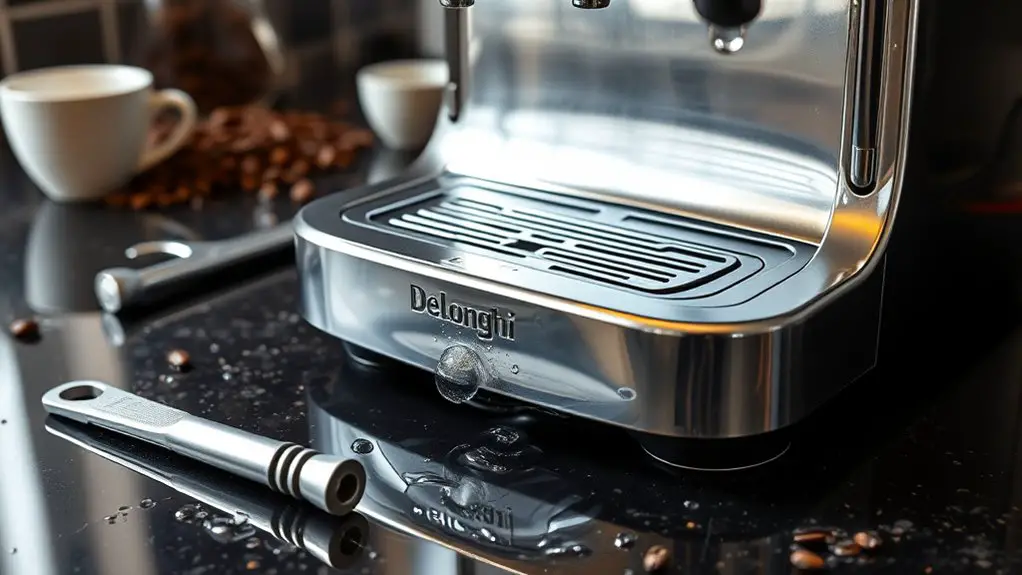To fix your leaking De'Longhi espresso machine, start by checking for water pooling around the unit. Inspect the water reservoir for proper seating and look for cracks or damaged seals. Clean the drip tray and brew unit to avoid blockages, and replace any worn seals with model-specific parts. If the leak persists, consider seeking professional repair services to address potential internal issues. There's more to explore about effective maintenance and repair techniques.
Identifying the Source of the Leak
Have you noticed water pooling around your De'Longhi espresso machine? Identifying the source of the leak is vital for restoring your machine's functionality. Common leak causes often include a clogged drip tray, loose water reservoir, or faulty connections. Start troubleshooting by checking the water reservoir; verify it's seated correctly. Inspect the drip tray for blockages, and clean any accumulated debris. Next, examine the water supply line for cracks or loose fittings. If you've got an internal leak, listen for unusual noises that might indicate a malfunctioning pump. By systematically addressing these common issues, you can pinpoint the source of the leak, allowing you to enjoy the freedom of brewing perfectly crafted espresso once more.
Checking and Replacing Worn Seals
When dealing with a leak in your De'Longhi espresso machine, checking and replacing worn seals is vital, as these components can deteriorate over time and lead to water loss. Start by inspecting the seals around the brewing unit and water pathways for signs of wear or damage. If you notice cracks or deformities, it's time for seal replacement. Make sure you have the correct replacement seals specific to your model for peak performance. Regular seal maintenance is important; clean the areas around the seals to prevent buildup that can accelerate wear. Once replaced, reassemble your machine and test for leaks. Keeping seals in good condition can greatly enhance your espresso machine's longevity and efficiency, granting you the freedom to enjoy uninterrupted brewing.
Inspecting the Water Reservoir
Although you might not immediately suspect the water reservoir, inspecting it is essential for identifying leaks in your De'Longhi espresso machine. Start by removing the reservoir and checking for any visible cracks or damage. Pay close attention to the seals and gaskets—these components can deteriorate over time, leading to leaks. Make certain the reservoir is seated correctly in its housing; misalignment can cause improper sealing. Look for water marks or mineral buildup around the base, as these are indicators of past leaks. If you detect any issues, replace the affected parts to enhance leak prevention. Regularly inspecting the water reservoir will not only extend your machine's life but also guarantee you enjoy consistently great espresso.
Cleaning the Drip Tray and Brew Unit
To maintain ideal performance and prevent leaks in your De'Longhi espresso machine, it is vital to regularly clean the drip tray and brew unit. Start by removing the drip tray, rinsing it under warm water, and using a non-abrasive sponge to eliminate any residue. For the brew unit, detach it from the machine and rinse it thoroughly, ensuring you remove coffee oils and grounds. Employ effective cleaning techniques, like soaking stubborn stains in warm water for a few minutes. After cleaning, allow all components to dry completely before reassembling. Incorporating these maintenance tips into your routine will greatly enhance your machine's longevity and efficiency, minimizing the chances of leaks and ensuring your espresso stays deliciously fresh.
Seeking Professional Repair Services
Are you struggling to identify the source of a persistent leak in your De'Longhi espresso machine? If so, it might be time to seek professional repair services. Technicians can perform a thorough diagnostic to pinpoint issues like faulty seals, worn gaskets, or malfunctioning pumps—problems that often elude the untrained eye. While repair costs can vary based on the extent of the damage, don't forget to check your warranty coverage. Many repairs may be covered, saving you significant expenses. Choosing a certified service center guarantees you're getting expertise specific to your machine, which can lead to a longer lifespan and better performance. Don't let a leak hinder your coffee experience; professional help can restore your espresso machine to its best condition.
Frequently Asked Questions
What Tools Do I Need to Fix a Leaking Espresso Machine?
To diagnose leaks, you'll need essential repair tools: a screwdriver set, wrenches, and silicone sealant. These will help you identify problematic areas and effectively seal any leaks, ensuring your espresso machine operates smoothly again.
How Often Should I Perform Maintenance on My De'longhi Machine?
You should follow a maintenance schedule every three months. Regular cleaning tips include descaling and checking seals. This proactive approach guarantees peak performance, prolongs your machine's life, and enhances your espresso experience without interruptions.
Can I Use Vinegar to Clean My Espresso Machine?
Imagine a knight battling stubborn stains. You can indeed use vinegar for espresso cleaning; its benefits include descaling and removing odor. Just don't forget to rinse thoroughly to guarantee your brew remains untainted and flavorful.
Is My Warranty Still Valid if I Attempt Repairs?
If you attempt repairs, you might void your warranty coverage. It's essential to check your warranty terms; unauthorized repairs can lead to repair consequences that prevent you from receiving future service or replacements. Proceed cautiously.
What Should I Do if the Leak Continues After Repairs?
If the leak persists after repairs, it's like a never-ending waterfall! Employ leak detection methods, and follow troubleshooting tips to pinpoint the source. Don't hesitate to consult a professional if the problem continues.
